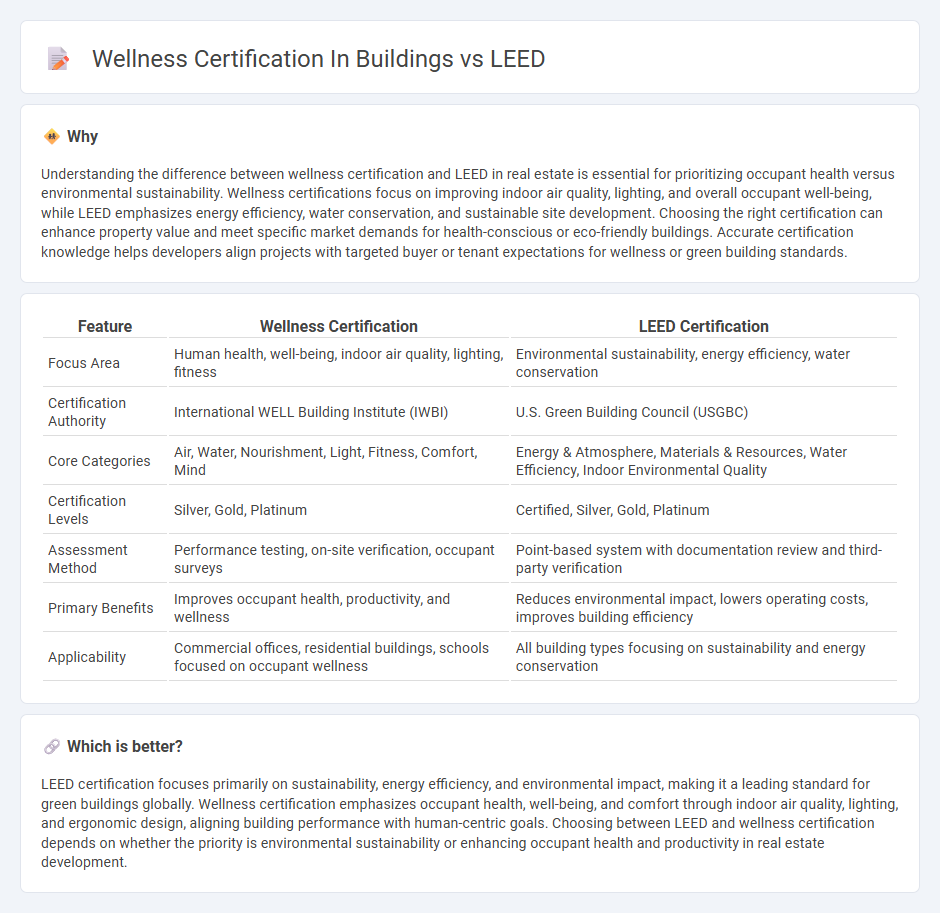
Wellness certification in buildings focuses on enhancing occupant health and well-being through improved indoor air quality, natural lighting, and ergonomic design, distinguishing it from LEED, which primarily emphasizes environmental sustainability and energy efficiency. Key wellness standards like WELL Certification assess factors such as hydration, fitness, and mental health, complementing LEED's goals of reducing carbon footprint and resource use. Explore the distinct benefits and applications of wellness certification versus LEED to optimize building performance for both people and the planet.
Why it is important
Understanding the difference between wellness certification and LEED in real estate is essential for prioritizing occupant health versus environmental sustainability. Wellness certifications focus on improving indoor air quality, lighting, and overall occupant well-being, while LEED emphasizes energy efficiency, water conservation, and sustainable site development. Choosing the right certification can enhance property value and meet specific market demands for health-conscious or eco-friendly buildings. Accurate certification knowledge helps developers align projects with targeted buyer or tenant expectations for wellness or green building standards.
Comparison Table
| Feature | Wellness Certification | LEED Certification |
|---|---|---|
| Focus Area | Human health, well-being, indoor air quality, lighting, fitness | Environmental sustainability, energy efficiency, water conservation |
| Certification Authority | International WELL Building Institute (IWBI) | U.S. Green Building Council (USGBC) |
| Core Categories | Air, Water, Nourishment, Light, Fitness, Comfort, Mind | Energy & Atmosphere, Materials & Resources, Water Efficiency, Indoor Environmental Quality |
| Certification Levels | Silver, Gold, Platinum | Certified, Silver, Gold, Platinum |
| Assessment Method | Performance testing, on-site verification, occupant surveys | Point-based system with documentation review and third-party verification |
| Primary Benefits | Improves occupant health, productivity, and wellness | Reduces environmental impact, lowers operating costs, improves building efficiency |
| Applicability | Commercial offices, residential buildings, schools focused on occupant wellness | All building types focusing on sustainability and energy conservation |
Which is better?
LEED certification focuses primarily on sustainability, energy efficiency, and environmental impact, making it a leading standard for green buildings globally. Wellness certification emphasizes occupant health, well-being, and comfort through indoor air quality, lighting, and ergonomic design, aligning building performance with human-centric goals. Choosing between LEED and wellness certification depends on whether the priority is environmental sustainability or enhancing occupant health and productivity in real estate development.
Connection
Wellness certification in buildings and LEED (Leadership in Energy and Environmental Design) both focus on improving indoor environmental quality, energy efficiency, and occupant health, contributing to sustainable real estate development. LEED provides a comprehensive framework for green building practices, while wellness certification emphasizes occupant well-being through features like air quality, natural lighting, and active design. Integrating LEED standards with wellness certification enhances property value by creating healthier, environmentally responsible spaces that meet the growing demand for sustainable living and working environments.
Key Terms
Sustainability
LEED certification emphasizes comprehensive sustainability metrics including energy efficiency, water conservation, and reduced carbon footprint, promoting environmentally responsible building practices. Wellness certification focuses on occupant health and comfort by optimizing indoor air quality, natural lighting, and ergonomic design, thereby enhancing wellbeing within sustainable structures. Explore the detailed comparisons between LEED and wellness certifications to understand their roles in advancing green and healthy buildings.
Indoor Environmental Quality
LEED certification emphasizes energy efficiency, sustainable site development, and Indoor Environmental Quality (IEQ) through standards in air quality, thermal comfort, and lighting to promote occupant health. Wellness certification, such as WELL Building Standard, centers more specifically on human health and wellbeing by improving IEQ via advanced parameters like VOC reduction, circadian lighting design, and enhanced ventilation strategies. Explore comprehensive differences and strategies to optimize your building's indoor environment effectively.
Health Performance
LEED certification emphasizes sustainable building practices such as energy efficiency and water conservation, while wellness certifications like WELL prioritize occupant health and indoor environmental quality factors including air quality, daylight, and thermal comfort. Health performance metrics in wellness certifications focus on measurable impacts on physical and mental wellbeing, promoting strategies that reduce stress and enhance productivity. Explore the detailed benefits and differences between LEED and wellness certifications for building health performance.
Source and External Links
What is LEED? - LEED is a green building certification process by the U.S. Green Building Council that evaluates building projects based on environmental impacts and sustainability.
LEED - Wikipedia - LEED is a globally recognized green building certification program developed by the U.S. Green Building Council to promote environmentally responsible construction and operation.
Local Employment and Economic Development Programme (LEED) - This LEED program supports OECD governments in promoting local job creation, social inclusion, and economic growth through practical policy solutions.
 dowidth.com
dowidth.com